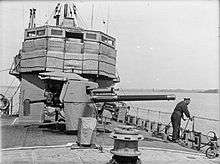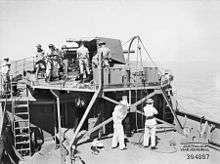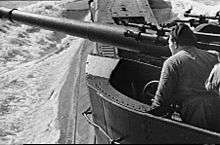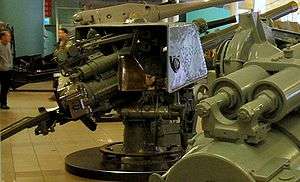QF 4 inch naval gun Mk IV, XII, XXII
| Ordnance QF 4 inch gun Mk IV, XII, XXII | |
|---|---|
|
Mk IV gun from HMS Lance at the Imperial War Museum, London | |
| Type |
Light Naval gun Submarine gun |
| Place of origin | United Kingdom |
| Service history | |
| In service | 1911-1940s |
| Used by |
|
| Wars |
World War I World War II |
| Specifications | |
| Weight | 2,750 pounds (1,250 kg) barrel & breech |
| Barrel length | 160 inches (4.064 m) bore (40 calibres) |
|
| |
| Shell |
Mk IV : Separate QF 31 pounds (14.06 kg); Mk XII & XXII : Fixed QF 31 pounds (14.06 kg), 35 pounds (15.88 kg) from 1944[1] |
| Calibre | 4-inch (101.6 mm) |
| Breech | horizontal sliding block |
| Muzzle velocity |
Mk IV : 2,370 feet per second (720 m/s)[2] Mk XII & XXII : 1,873 feet per second (571 m/s) |
| Maximum firing range | 10,000 yards (9,100 m) |
The QF 4-inch gun Mk IV[note 1] was the main gun on most Royal Navy and British Empire destroyers in World War I. It was introduced in 1911 as a faster-loading light gun successor to the BL 4 inch Mk VIII gun. Mk XII and Mk XXII variants armed many British interwar and World War II submarines.
Mk IV gun


Mk IV armed many British destroyers and some cruisers in World War I. It was used to arm merchant ships in World War II.
The guns armed the following warships :
- Forward-class scout cruisers as re-gunned in 1911
- Sentinel-class scout cruisers as re-gunned 1911-1912
- Pathfinder-class scout cruisers as re-gunned 1911-1912
- Adventure-class scout cruisers as re-gunned 1911-1912
- Acasta (K)-class destroyers of 1911
- Laforey (L)-class destroyers of 1913
- Yarrow M-class destroyers laid down 1912 - 1915
- Admiralty M-class destroyer of 1913
- Thornycroft M-class destroyers laid down 1913 - 1915
- Hawthorn M-class destroyer of 1914
- Talisman-class destroyers of 1914
- Medea-class destroyers of 1914
- Faulknor-class leaders of 1914
- Marksman-class destroyers of 1914
- Parker class leaders of 1915
- Yarrow Later M-class destroyers of 1915
- R-class destroyers of 1916
- S-class destroyers of 1917
- Fundy-class minesweepers of 1938 (guns from decommissioned Canadian S-class destroyers)
Mk XII and XXII submarine gun

The Mk XII variant was developed for arming submarines from 1918, Mk XXII was developed to arm submarines during World War II. These submarine guns fired a heavier 35 pounds (16 kg) projectile from late 1944.[1] Shortly after the end of hostilities, the Mk XXII was superseded in new British submarines by the lighter QF 4 inch Mk XXIII.[3]
Mk XII and XXII equipped submarines
- L class
- Odin ("O") class
- Parthian ("P") class
- River (or Thames) class
- Grampus (or Porpoise) class
- Triton ("T") class
- S class
- Some of the Amphion ("A" or Acheron) class
Surviving guns
- The Mk IV gun from HMS Lance which fired the first British shot of World War I on 5 August 1914 is on display at the National Museum of the Royal Navy, Portsmouth.
See also
Weapons of comparable role, performance and era
- 10.5 cm SK C/32 naval gun : Slightly more powerful German equivalent WWII submarine gun
Notes
- ↑ Mk IV = Mark 4. Britain used Roman numerals to denote Marks (models) of ordnance until after World War II. This was the fourth model of 4-inch QF naval gun. Variants Mk XII = Mark 12, Mk XXII = Mark 22.
References
- 1 2 DiGiulian
- ↑ 2,370 ft/s for Mk IV gun with 31 lb (14 kg) projectile in WWI, using 5 lb 1 oz 12 drams cordite MD size 16 propellant (Treatise on Ammunition, 10th Edition 1915)
- ↑ "Britain - 4"/33 (10.2 cm) QF Mark XXIII". www.navweaps.com. Tony DiGiulian. 22 October 2008. Retrieved 21 March 2014.
Sources
- Tony DiGiulian, British 4"/40 (10.2 cm) QF Marks IV, XII and XXII
| Wikimedia Commons has media related to QF 4 inch Mk IV naval gun. |

